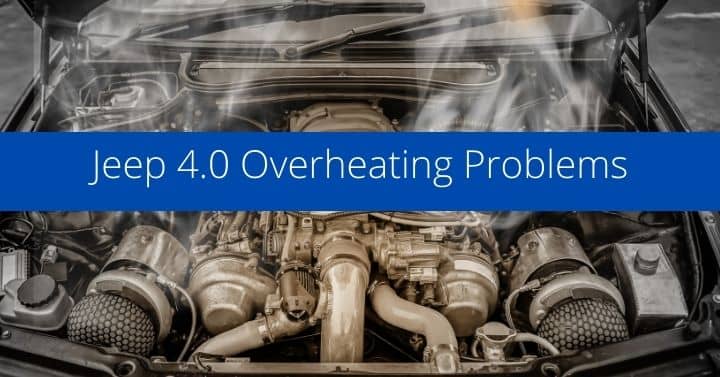Yes, Jeep Wranglers are genuinely some of the superior vehicles out there. The performance that they offer is hard to rival. However, even if you have the best of the best, you will face some problems after riding them for a prolonged time. And when it comes to the Jeep 4.0, overheating seems to be the most common one.
So, what do you do when facing Jeep 4.0 overheating problems? Can you diagnose the issues on your own and fix them? Well, that is indeed possible. And in this guide, we will let you know about the process. Along with that, you can learn all of the common symptoms that will tell you whether your Jeep is overheating or not.
What Causes The Jeep 4.0 Overheating Problems And How to Solve Them?
Let us get right into the topic at hand. So, the overheating issue can arise for many different reasons. And various components might be contributing to the problems. To give you a proper idea of the issues, we will go through each factor in this segment.
1. Radiator Fan Clutch
Among all of the components that can cause overheating issues, problems with the fan clutch are the most common. When the radiator is not pulling in enough air, the engine will find it hard to maintain the optimal operating temperature. Eventually, it will start to overheat.
How to Tell That The Radiator Fan Is Causing The Overheating Issues
So, there are two ways you can tell whether the radiator fan clutch is the root of the problems or not. Firstly, if you notice that the fan is not rotating smoothly and seems to be a bit gritty or stuck in one place, you can be sure that it is the leading cause of the issues.
The second way to tell is through observing the clutch fan. Start the engine and let it reach the operating temperature. Is the fan engaging like how it should be? Also, notice the fan when you are turning the engine off. Is it still rotating for a couple of seconds? If the answer is no for any of the cases, it is the root cause of the issues.
Furthermore, if there is a missing pin or damage to the radiator fan, it might cause the engine to overheat.
Fix
Unfortunately, if the Wrangler is overheating due to the radiator fan, you will need to get it replaced. However, you should not wait around. Replace the fan as soon as you diagnose the issue.
2. Air Block
Is the engine overheating while idling, and does it drop when you drive it? Does the temperature rise again after you keep the Wrangler idle again? Well, there is an air block. Now, you will need to inspect two things to be extra sure regarding the matter. First, check whether the radiator cap sealing is there or not.
Secondly, check whether the is an airlock system in your Jeep. If the cap sealing is in place, there is a high chance that your cooling system has air blocks.
Symptoms of Air Locks in The Cooling System
- The radiator has recently boiled over due to the missing or loose cap
- Temperature drops while driving but rises while idling
- Increasing speed decreases the temperatures
How to Burp Out Air from The Cooling System
If you are sure that there are air blocks in the cooling system, follow these steps to get the air out:
- Park the vehicle with the nose in the inclined position
- Take the radiator cap off
- Turn the engine on and allow it to get to the normal operating temperature
- Squeeze the upper water hose in order to force all of the air bubbles out of the system
- Keep a close eye on the coolant levels
- If the coolant level decreases, top it up
- Repeat the steps to the point where the overheating issue is gone, but let the bubbles settle overnight before repeating the process
3. Take Down The Auxiliary Fan Upgrade
Electric fans on the Wranglers might sound like an upgrade. But in reality, they are a massive downgrade to the cooling system. The thing is, the auxiliary fans will work like a charm on other vehicles. But the 4.0 Jeep Wrangler is not one of them. The fans will not provide enough airflow to the radiator.
For that reason, if you have one of these on your Wrangler, you should take them off. Put the serpentine belt-drive fan back in place and check whether the issues still persist or not.
4. Thermostat
Basically, the main task of the thermostat is to monitor the overall temperature of the engine and turn the fan on when necessary. The Wrangler 4.0 will come with a cooling system that needs a 195 degrees thermostat. And if there are any issues with it, the Check Engine light will turn on. So, if you see the light, replace the thermostat.
Also read: What are the symptoms of a bad thermostat
5. Water Pump
The water pump of your Jeep can cause the engine to overheat. Just like any other component of the Wrangler, it can stop working after a while. And if there is not enough coolant level, the water pump impeller will start to corrode and wear down. This corrosion can cause the system to scale and eventually clog the flat tubes.
When the tubes start to wear down, you will lose coolant quickly. So, if you inspect and find out the water pump problem, you should replace the system as soon as possible.
6. Coolant
Low or lack of coolant is another reason your Wrangler is overheating. And if you do not use proper coolant or flush the system down frequently, the cooling system will not function properly. So, in case you did not do coolant maintenance anytime soon, you should do it and check whether the problems persist or not.
Secondly, if you are not using the proper coolant, you should upgrade it. Remember, the coolant has loads of additives that prevent corrosion inside the system. Therefore, you will be bound to face issues if you rely on a low-grade one.
7. Radiator Cap Seals
Although the radiator cap might seem like an insignificant component, it plays a crucial role in maintaining the temperature of the engine. In fact, if you have e new radiator cap, you will face engine issues when it is not meant for your Wrangler. So, we suggest checking whether you have the right radiator cap or not.
Now, if you are purchasing a new radiator cap, you should not opt for anything other than the ones that are OE quality. Usually, those will be of heavy-duty steel and provide the right sealing level. Eventually, the engine will cool down efficiently with those.
8. Condition of The Radiator
Needless to say, the radiator is the most crucial part of the Wrangler. It ensures that the engine is in optimal condition and does not overheat when the vehicle is on load. You will find it in the front of the Jeep. And it would usually activate when you drive your Jeep.
When you move your Jeep forward, the cool air will get into the narrow tubes, and the radiator will utilize it to keep the engine. The radiator will also utilize the cooling fluid. It will cool the liquid down and make them circulate around the engine. This process eventually ensures an optimal operating temperature.
9. Insufficient Flow of Air
A lot of the Jeep owners customize the overall components. They will fit the Wranglers up with massive winches, spotlights, and LED bars. And most of the modifications will be at the front. That is right! These modifications can block the radiator of the Wrangler.
Now, when the radiator does not get the right level of airflow, it will fail to cool down the engine properly. For that reason, if you are facing overheating issues, check whether you have these on your Wrangler or not:
- Metal mesh grill protectors
- Gress seed nets
- Oversized winches
- Oversized spotlights
- LED light bars on the front grill
If you happen to have one of these modifications on your Wrangler, you should take them off. Check whether the overheating issues go away after you take them off. But if you do not see the condition improving, you need to try out the other fixes we discussed earlier.
Frequently Asked Questions
Do all Jeeps overheat?
The overheating problem with the Jeep Wrangler is pretty typical. And in most cases, it is because of a coolant leak, which can happen due to a malfunctioning radiator, water pump, hoses, and others.
How can I make my Jeep run cooler?
One of the easiest ways to make your Jeep run cooler would be to change the water to coolant ratio. And in this case, you should work on increasing the amount of water and lowering the percentage of the coolant. A prime example of good water to coolant ratio for keeping the Jeep cool would be 70:30.
What is the normal temperature range for Jeep?
Typically, the temperature should hover anywhere from 206 to 226. And when the temperature exceeds 226 Fahrenheit, the fan should kick in. Now, if the fan is working correctly, it should quickly drag the temperature down to the normal range.
Is 230 Fahrenheit a bad temperature for Jeep?
If the temperature is hitting the 230 mark and the fan is not correctly lowering it, it is a bad temperature. Usually, you might see the Jeep running at that temperature during the summers.
Final Words
Basically, the Jeep 4.0 overheating problems are pretty common. And in most cases, it is because of the radiator fan clutch. So, before you try out the other fixes, you should check the radiator fan clutch. If it seems to be working fine, try out the other fixes we have mentioned. But if everything fails, get the Jeep to a repair shop.

